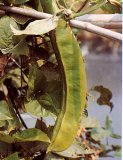Sword Bean
http://www.100md.com
《e Natural Health Center》
 |
 |
 |
Nuts and Seeds
Sword Bean
Latin:
Canavalia gladiata
Origin:
The seed of the plant Canavalia gladiata (Jacq.) DC., of the Leguminosae family. Sword Bean is probably native to southern Asia or possibly Africa. It is known chiefly as a cultivated species and may have been derived by selection from Canavalia virosa, a wild species occurring principally in Africa.
, http://www.100md.com
Sword Bean is cultivated widely in South and Southeast Asia, especially in India, Sri Lanka, and Burma. Sword Bean is a minor vegetable, now spread throughout the humid tropics but grown chiefly for local consumption.
Sword Bean seeds germinate readily. Optimum growth occurs in full sunlight but sword beans are tolerant of some shade. Preferred environmental conditions are found in the humid lowland tropics but these beans may be grown with success in tropical elevations to 1,000 m. Sword Bean thrives in tropical climates exhibiting moderately high temperature (15-30° C) environments. Sword Bean is tolerant of a wide range of rainfall conditions (from 700-4,200 mm).
, 百拇医药
Young green pods are eaten as a cooked vegetable in Asia. Possibilities exist for using this bean species as a source of purified protein and starch concentrates as food supplements or for use in livestock feeds. Sword Bean, like Jack Bean (Canavalia ensiformis), is a source of an enzyme, urease, which has been exploited commercially. Sword Bean is useful as a cover crop and as a green manure. Its use as raw livestock feed is limited by the growth inhibiting substances it contains.
, http://www.100md.com
Sword beans are fast growing. The young stem tips and leaves are eaten as a cooked vegetable. Young pods are available 3-4 months after planting. Pick pods when half-grown, 10-15 cm long, before pod swelling occurs.
Also called Japanese Jack Bean, or Jack Bean.
Properties:
Sweet in flavor, warm in nature, it is related to the channels of the stomach and kidney.
, 百拇医药
Functions:
Warms the middle region (spleen and stomach), pushes qi (energy) downward, benefits kidneys, tones yang (male energy).
Applications:
Sword bean is used for hiccups due to cold and deficiency, vomiting, abdominal swelling, lumbago (lower back pain) due to kidney deficiency, asthma with sputum.
1. For abdominal pain, vomiting, hiccups, etc., due to deficiency of the spleen and stomach:
, 百拇医药
Boil sword beans with fresh ginger and tangerine peel in water and drink the soup.
2. For lumbago due to deficiency of the kidneys:
Boil sword beans with a couple of pork kidneys in water for one hour. Drink the soup and consume the food.
Dosage and Administration:
Boil in soup, or grind into powder form for topical application. Young pods can be sliced and pickled in soy sauces. The young leaves may be cooked and eaten as a potherb.
, 百拇医药
Cooked mature seeds have little flavor and a mealy texture, reducing their appeal as a human food source.
Cautions on Use:
Full-size soft green seeds may be eaten cooked although they may contain low amounts of growth-inhibiting substances canavalin and concanavalin A. Ripe seeds require 5-10 months to mature. Mature seeds, or dried seeds that have been in storage, must be cooked thoroughly as they contain toxic protein substances referred above.
, 百拇医药
Reference Materials:
Toxic or Side Effects:
Mature seeds are toxic and must not be eaten unless they are extensively cooked (3 hours or more recommended) preferably using 2-3 changes of water, and the tough seed coats are removed.
Modern Researches:
Sword bean contains protein, fat, sugars, and is low in calorie.
, 百拇医药
Both the foliage and the seeds contain growth-inhibiting protein substances, canavalin and concanavalin A (Con A) and the amino acid, canavanine. Con A has antibody-like properties and it has been reported to provide a beneficial effect to plants possessing it, providing possible protection to the plants from disease microorganisms. However, Con A binds to mucosal cells lining the human digestive tract reducing the ability of the intestine to absorb nutrients. The concentration of these growth-inhibiting substances increases as the plant tissues age and mature. It is for this reason that human consumption is best limited to only the younger foliage and pods of these beans.
, http://www.100md.com
Sword bean also contains gibberellin A-15, a growth-promoting hormone and its leaf meal has been shown to be a good source of pigment for egg yolks but information on its nutritive value is quite sketchy.
The dried beans of sword bean are good sources of protein and starch, 27 percent protein and 42 percent starch respectively, with a good balance of amino acids., http://www.100md.com